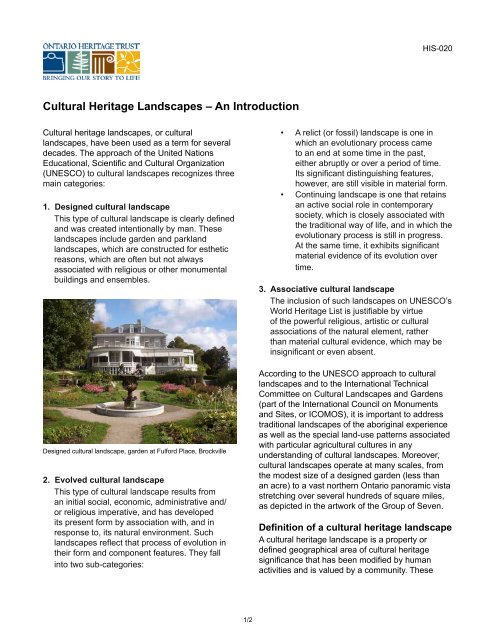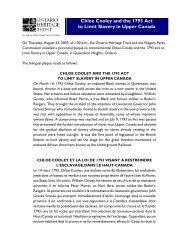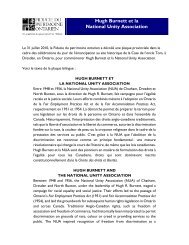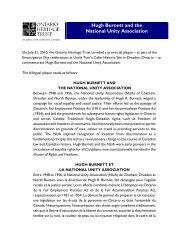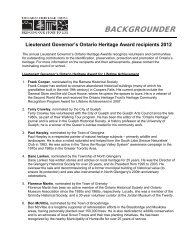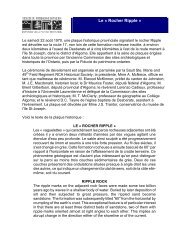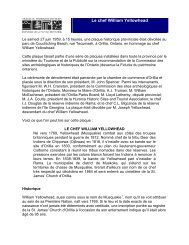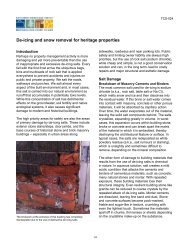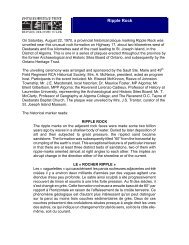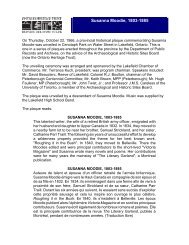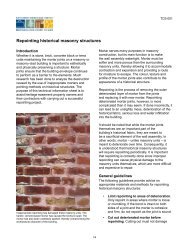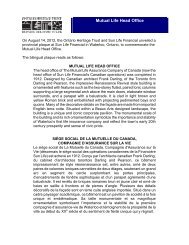Cultural Heritage Landscapes â An Introduction
Cultural Heritage Landscapes â An Introduction
Cultural Heritage Landscapes â An Introduction
You also want an ePaper? Increase the reach of your titles
YUMPU automatically turns print PDFs into web optimized ePapers that Google loves.
HIS-020<br />
<strong>Cultural</strong> <strong>Heritage</strong> <strong>Landscapes</strong> – <strong>An</strong> <strong>Introduction</strong><br />
<strong>Cultural</strong> heritage landscapes, or cultural<br />
landscapes, have been used as a term for several<br />
decades. The approach of the United Nations<br />
Educational, Scientific and <strong>Cultural</strong> Organization<br />
(UNESCO) to cultural landscapes recognizes three<br />
main categories:<br />
1. Designed cultural landscape<br />
This type of cultural landscape is clearly defined<br />
and was created intentionally by man. These<br />
landscapes include garden and parkland<br />
landscapes, which are constructed for esthetic<br />
reasons, which are often but not always<br />
associated with religious or other monumental<br />
buildings and ensembles.<br />
Designed cultural landscape, garden at Fulford Place, Brockville<br />
2. Evolved cultural landscape<br />
This type of cultural landscape results from<br />
an initial social, economic, administrative and/<br />
or religious imperative, and has developed<br />
its present form by association with, and in<br />
response to, its natural environment. Such<br />
landscapes reflect that process of evolution in<br />
their form and component features. They fall<br />
into two sub-categories:<br />
• A relict (or fossil) landscape is one in<br />
which an evolutionary process came<br />
to an end at some time in the past,<br />
either abruptly or over a period of time.<br />
Its significant distinguishing features,<br />
however, are still visible in material form.<br />
• Continuing landscape is one that retains<br />
an active social role in contemporary<br />
society, which is closely associated with<br />
the traditional way of life, and in which the<br />
evolutionary process is still in progress.<br />
At the same time, it exhibits significant<br />
material evidence of its evolution over<br />
time.<br />
3. Associative cultural landscape<br />
The inclusion of such landscapes on UNESCO’s<br />
World <strong>Heritage</strong> List is justifiable by virtue<br />
of the powerful religious, artistic or cultural<br />
associations of the natural element, rather<br />
than material cultural evidence, which may be<br />
insignificant or even absent.<br />
According to the UNESCO approach to cultural<br />
landscapes and to the International Technical<br />
Committee on <strong>Cultural</strong> <strong>Landscapes</strong> and Gardens<br />
(part of the International Council on Monuments<br />
and Sites, or ICOMOS), it is important to address<br />
traditional landscapes of the aboriginal experience<br />
as well as the special land-use patterns associated<br />
with particular agricultural cultures in any<br />
understanding of cultural landscapes. Moreover,<br />
cultural landscapes operate at many scales, from<br />
the modest size of a designed garden (less than<br />
an acre) to a vast northern Ontario panoramic vista<br />
stretching over several hundreds of square miles,<br />
as depicted in the artwork of the Group of Seven.<br />
Definition of a cultural heritage landscape<br />
A cultural heritage landscape is a property or<br />
defined geographical area of cultural heritage<br />
significance that has been modified by human<br />
activities and is valued by a community. These<br />
1/2
Standards and Guidelines for Conservation of<br />
Historic Places in Canada, Section 4.1: Guidelines<br />
for <strong>Cultural</strong> <strong>Landscapes</strong>, including <strong>Heritage</strong><br />
Districts:<br />
www.historicplaces.ca/media/18072/81468-parkss+g-eng-web2.pdf<br />
Parks Canada’s information on Aboriginal <strong>Cultural</strong><br />
<strong>Landscapes</strong>:<br />
www.pc.gc.ca/docs/r/pca-acl/index.aspx<br />
Evolved cultural landscape, Scotsdale Farm, Halton Hills<br />
activities or uses may be key to the cultural value,<br />
significance and meaning of this landscape.<br />
A cultural landscape may be designed at a specific<br />
time by a specific person or it may have evolved<br />
organically over a long period time (and may still be<br />
slowly evolving). It may also include a landscape<br />
that possesses powerful religious, artistic or<br />
cultural associations of the natural element<br />
rather than material cultural evidence, which<br />
may be insignificant or even absent. It involves a<br />
grouping(s) of individual heritage features, such as<br />
structures, spaces, archaeological sites and natural<br />
elements that together form a significant type of<br />
heritage form, distinctive from that of its constituent<br />
elements or parts.<br />
Examples may include, but are not limited to:<br />
heritage conservation districts (designated under<br />
the Ontario <strong>Heritage</strong> Act), villages, parks, gardens,<br />
battlefields, main streets and neighbourhoods,<br />
cemeteries, shrines and special spiritual places,<br />
aboriginal landscapes, trails, views, vistas, view<br />
corridors, land-use patterns, traditional agricultural<br />
lands and industrial complexes of cultural heritage<br />
value.<br />
For more information on cultural<br />
landscapes<br />
ICOMOS’ International Scientific Committee on<br />
cultural landscapes:<br />
www.icomos.org/landscapes/index2engl.htm<br />
National Capital Commission:<br />
www.canadascapital.gc.ca/bins/ncc_web_<br />
content_page.asp?cid=16300-20450-<br />
27621&lang=1&bhcp=1<br />
Regional Municipality of Waterloo:<br />
www.environment.uwaterloo.ca/research/<br />
hrc/documents/12%20Region%20CHL%20-<br />
%20with%20title%20page.pdf<br />
City of Mississauga cultural landscape inventory:<br />
www5.mississauga.ca/pdfs/<strong>Cultural</strong>_Landscape_<br />
Inventory_Jan05.pdf<br />
Associative cultural landscape, Kay-Nah-Chi-Wah-Nung, Manitou<br />
Mounds, Stratton<br />
Revised November 2012<br />
Ontario <strong>Heritage</strong> Trust Toronto, ON T 416-325-5000 www.heritagetrust.on.ca<br />
10 Adelaide Street East M5C 1J3 F 416-325-5071 programs@heritagetrust.on.ca<br />
2/2


